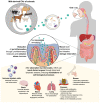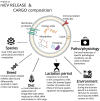Extracellular Vesicles from Animal Milk: Great Potentialities and Critical Issues
- PMID: 36496752
- PMCID: PMC9740508
- DOI: 10.3390/ani12233231
Extracellular Vesicles from Animal Milk: Great Potentialities and Critical Issues
Abstract
Other than representing the main source of nutrition for newborn mammals, milk delivers a sophisticated signaling system from mother to child that promotes postnatal health. The bioactive components transferred through the milk intake are important for the development of the newborn immune system and include oligosaccharides, lactoferrin, lysozyme, α-La, and immunoglobulins. In the last 15 years, a pivotal role in this mother-to-child exchange has been attributed to extracellular vesicles (EVs). EVs are micro- and nanosized structures enclosed in a phospholipidic double-layer membrane that are produced by all cell types and released in the extracellular environment, reaching both close and distant cells. EVs mediate the intercellular cross-talk from the producing to the receiving cell through the transfer of molecules contained within them such as proteins, antigens, lipids, metabolites, RNAs, and DNA fragments. The complex cargo can induce a wide range of functional modulations in the recipient cell (i.e., anti-inflammatory, immunomodulating, angiogenetic, and pro-regenerative modulations) depending on the type of producing cells and the stimuli that these cells receive. EVs can be recovered from every biological fluid, including blood, urine, bronchoalveolar lavage fluid, saliva, bile, and milk, which is one of the most promising scalable vesicle sources. This review aimed to present the state-of-the-art of animal-milk-derived EV (mEV) studies due to the exponential growth of this field. A focus on the beneficial potentialities for human health and the issues of studying vesicles from milk, particularly for the analytical methodologies applied, is reported.
Keywords: anti-inflammatory; biomarkers; delivery system; drug delivery; extracellular vesicles; immunomodulating; mEVs; milk; milk-derived EVs; theranostics.
Conflict of interest statement
The authors declare no conflict of interest.
Figures


Similar articles
-
Anti-Inflammatory Potential of Cow, Donkey and Goat Milk Extracellular Vesicles as Revealed by Metabolomic Profile.Nutrients. 2020 Sep 23;12(10):2908. doi: 10.3390/nu12102908. Nutrients. 2020. PMID: 32977543 Free PMC article.
-
Milk-Derived Extracellular Vesicles in Inter-Organism, Cross-Species Communication and Drug Delivery.Proteomes. 2020 May 13;8(2):11. doi: 10.3390/proteomes8020011. Proteomes. 2020. PMID: 32414045 Free PMC article. Review.
-
Biocompatibility of highly purified bovine milk-derived extracellular vesicles.J Extracell Vesicles. 2018 Feb 21;7(1):1440132. doi: 10.1080/20013078.2018.1440132. eCollection 2018. J Extracell Vesicles. 2018. PMID: 29511463 Free PMC article.
-
Abundantly Present miRNAs in Milk-Derived Extracellular Vesicles Are Conserved Between Mammals.Front Nutr. 2018 Sep 18;5:81. doi: 10.3389/fnut.2018.00081. eCollection 2018. Front Nutr. 2018. PMID: 30280098 Free PMC article.
-
Milk extracellular vesicles: A burgeoning new presence in nutraceuticals and drug delivery.Bioeng Transl Med. 2025 Jan 23;10(3):e10756. doi: 10.1002/btm2.10756. eCollection 2025 May. Bioeng Transl Med. 2025. PMID: 40385535 Free PMC article. Review.
Cited by
-
Bispecific Antibodies, Nanobodies and Extracellular Vesicles: Present and Future to Cancer Target Therapy.Biomolecules. 2025 Apr 29;15(5):639. doi: 10.3390/biom15050639. Biomolecules. 2025. PMID: 40427532 Free PMC article. Review.
-
Emerging technologies towards extracellular vesicles large-scale production.Bioact Mater. 2025 Jun 13;52:338-365. doi: 10.1016/j.bioactmat.2025.06.005. eCollection 2025 Oct. Bioact Mater. 2025. PMID: 40585384 Free PMC article. Review.
-
Goat milk extracellular vesicles: immuno-modulation effects on porcine monocyte-derived macrophages in vitro.Front Immunol. 2023 Jun 16;14:1209898. doi: 10.3389/fimmu.2023.1209898. eCollection 2023. Front Immunol. 2023. PMID: 37469517 Free PMC article.
-
Application of Milk Exosomes for Musculoskeletal Health: Talking Points in Recent Outcomes.Nutrients. 2023 Nov 1;15(21):4645. doi: 10.3390/nu15214645. Nutrients. 2023. PMID: 37960298 Free PMC article. Review.
-
Antioxidant Potential of Exosomes in Animal Nutrition.Antioxidants (Basel). 2024 Aug 8;13(8):964. doi: 10.3390/antiox13080964. Antioxidants (Basel). 2024. PMID: 39199210 Free PMC article. Review.
References
-
- Morrin S.T., Buck R.H., Farrow M., Hickey R.M. Milk-Derived Anti-Infectives and Their Potential to Combat Bacterial and Viral Infection. J. Funct. Foods. 2021;81:104442. doi: 10.1016/j.jff.2021.104442. - DOI
-
- Tomé-Carneiro J., Fernández-Alonso N., Tomás-Zapico C., Visioli F., Iglesias-Gutierrez E., Dávalos A. Breast Milk MicroRNAs Harsh Journey towards Potential Effects in Infant Development and Maturation. Lipid Encapsulation Can Help. Pharmacol. Res. 2018;132:21–32. doi: 10.1016/j.phrs.2018.04.003. - DOI - PubMed
Publication types
LinkOut - more resources
Full Text Sources

